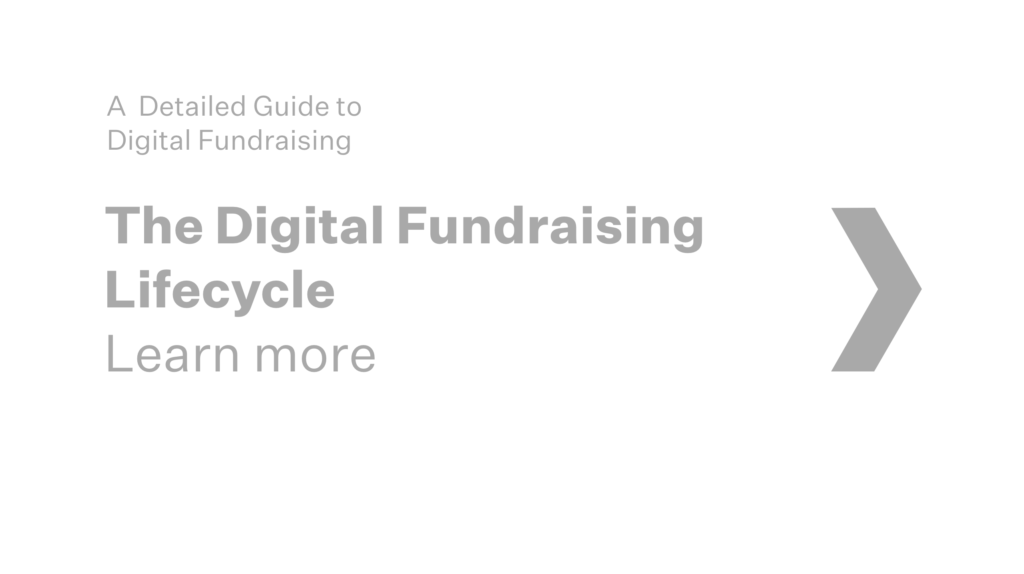
This article is part of the series, “A detailed Guide to Digital Fundraising”. Read the Table of Contents for a full list of articles.

This chapter provides a basic overview of how digital fundraising works in relation to attracting and converting a new investor. Starting with the first contact through to maintaining contact with your audiences. This concept is similar to the content framework which supports the decision-making process; however, the lifecycle is how you structure your tech as well as one of the many ways you segment your data.
4.1 INITIAL CONNECTION WITH AN INVESTOR
The first contact is usually the most important. An impression or serving an ad to someone (appearing in their feed) does not count as a contact. The first lead has to be a click which results in a visit to content on owned channels ie your website. The reason people rotate their content is to explore different ideas that might be relevant to a prospective investor and encourage them to make that first click. Analysis of your click-through rate is crucial when determining the success of the content that you are distributing. If your cookies are configured correctly and the user grants their usage, you should be able to capture some data that can be eventually used for remarketing (Google stores IP addresses for up to 90 days). Installing third-party tools like heatmaps and Reverse IP lookup allows you to analyse the movement of a user on your website and determine how they engage with your content; this allows you to make informed decisions and improve your website’s UX.
4.2 MAINTAINING CONTACT
As mentioned previously, once a click has generated a visit, you can then serve content to this individual through remarketing. This means you can create recipes that ensure content is only served through a small selection of relevant publishers. It is advisable to consider running content and campaigns in three month quarterly cycles. This means when a new campaign is launched you can remarket to all of the connections you built with the previous one.
4.3 PRODUCING THE FIRST CONVERSION
Once your content is performing well and you have provided further contact through remarketing you will find that connections start converting into new followers on your social channels. While this does provide more visibility on the individuals you are dealing with, it would appear odd to reach out and contact someone just because they followed you on LinkedIn. A first proper conversion happens on-site and results in meaningful information being provided with a level of intent. We covered conversions previously and examples vary, but if someone signs up on your site you automatically have more control over how to interact with this person. Assuming your forms, permissions and policies are configured and presented properly you can now focus on nurturing these contacts and relationships in order to achieve the final conversion of turning them into an investor.
4.4 FROM CONVERSION TO AN INVESTOR
At this point, there are decisions that need to be made based on the size or value of the opportunity and volume of conversions you have to manage. For large investment management opportunities or when charities are dealing with trusts, the relationship will very quickly be handed over to someone who is responsible for managing the opportunity. This is also where the tech side and CRM play a huge amount of importance, particularly if someone is already responsible for evaluating this organisation or person that is investing or donating. Your campaigns should be created in such a way that you can present further CTAs that support turning contacts into closer relationships. For example:
- Are you attending an event? Why not create a landing page to promote your attendance and add a CTA to arrange a meeting at this event.
- Do you have specific content that might be of relevance to an investor/major donor? Create a form/pop-up that offers the option of signing up solely to that content. Users are more likely to sign up for content that is more targeted and of relevance to them.
4.5 MANAGING YOUR INVESTOR CONTACTS AND AUDIENCES
Once an investor is converted there are a number of things that take place. Firstly, existing investors should be managed differently. You do want to keep in touch with them but you should only really distribute content that matches their interests. This person has now changed from a generic persona in to an individual investor with a personal profile. You should have a data set that is made up of just your existing investors and donors so that you can manage what you communicate and distribute to them.
There are systems you should put in place to maintain interest and engagement throughout the year. This includes coverage for your existing investor network – making sure they are continually up to date and engaged in your approach and offering.
It’s important to not forget about your ‘ex-investor’ contacts, which as long as they have not unsubscribed, can also be rotated content again to suit their interests. It’s possible to also add them to various flagship campaign types to keep them in touch with your organisation as it evolves. Just because they are not an active investor does not mean they are not interested in knowing about your organisation!
